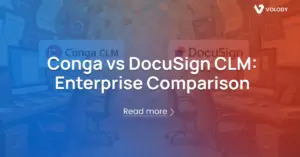Handling contracts is super important for any business to do well. It’s all about managing these agreements from when they’re made up until they end. But, it’s not always easy because there are a lot of steps and rules to follow which can make things tricky. In this blog, we’ll look at the 5 contract management challenges and share some tips on how to deal with them.
When dealing with contract management, you’ve got several stages like making the contract, talking terms over, getting approvals, putting it into action, and keeping an eye on things as they go along. Each part brings problems that could slow down or mess up the process. These issues range from having contracts scattered everywhere, hard-to-understand language in the agreements themselves and restrictions within those terms; losing track of different versions of a document; delays in getting approvals or signatures; and missing important dates or tasks that need attention.
To address these challenges directly so businesses stay compliant with laws, avoid risks, and better manage their agreement processes, strategies such as using one place to store all documents, ensuring proper tracking of changes, and organizing workflow activities can help smooth out issues and improve overall efficiency.
You might want to read: How To Manage Contracts Efficiently: Best Practices
Overcoming the Top 5 Challenges in Contract Management

For businesses to do well, managing contracts properly is key. This helps them follow rules, lessen risks, and get the best outcomes. But handling contracts from start to finish comes with its own set of problems. Here are the top 5 hurdles in contract management and some ways to deal with them.
1. Decentralized Contract Storage
One big problem with managing contracts is that they’re often kept in different places. Many companies still do things the old-fashioned way, using paper and manual methods to keep track of their contracts. This makes it hard to see what’s going on and tough to find important details when you need them. Additionally, when contracts are scattered across various locations, it can lead to missed deadlines and costly mistakes. The lack of a centralized system makes it challenging to ensure compliance and monitor contract performance effectively.
2. Complex Contract Language and Clause Limitations
Another big hurdle in managing contracts is the tough language and specific conditions they often include. It’s hard to get what these contracts mean sometimes, which can lead to confusion and even arguments. This complexity can make it difficult to understand our rights and responsibilities. Misinterpretations might cause delays and unexpected costs, further complicating the process.
3. Lack of Contract Version Control
One big problem with managing contracts is not being able to keep track of different versions. This happens a lot when many people are working on making and changing contracts. It’s hard to know which version is the latest. This confusion often leads to mistakes and misunderstandings. Having a system for version control can help keep everyone on the same page.
You might want to read: What Is A Contract Repository? Effective Contract Storage
4. Approval and Signature Bottlenecks
When it comes to managing contracts, getting approvals and signatures can slow things down. The old way of doing things usually means a lot of people need to sign off on something, and they all have to do it in person. This takes up a ton of time and can cause some serious hold-ups. These delays can be frustrating and can hinder the progress of important projects. To streamline the process, adopting digital approval and e-signature solutions can make a significant difference.
5. Overlooking Key Dates and Workflow Tasks
When you don’t keep an eye on important dates and tasks in managing contracts, it can cause big problems. Not staying on top of things like when to renew a contract, when payments are due, or what we’ve agreed to do can lead us to miss out on good stuff, face fines, or even break the agreement. Missing key deadlines can result in overlooked opportunities and penalties. Effective contract management requires careful attention to all important dates and tasks to ensure compliance and maximize benefits.
You might want to read: What Are Contract Obligations And How To Manage Them
7 Strategies to Address Challenges in Contract Management

To tackle the issue of scattered contract storage, companies can use a method like setting up a single place where all contracts are kept. This spot makes it easy for everyone who needs to see the contracts to find and access them, making sure they’re always looking at the latest versions. With everything in one place and the option to get to these documents from anywhere using cloud technology, businesses not only make things clearer and work together better but also ensure they’re following rules as required. By doing this, organizations help relevant stakeholders stay informed while meeting regulatory requirements efficiently.
1. Implementing a Centralized Contract Repository
To tackle the problem of having contracts all over the place, companies can set up a central spot where all their contracts live. This one spot acts like the go-to place for everything contract-related, getting rid of the need to dig through filing cabinets or jump between different digital spots.
With contract management software, setting up this central hub becomes easier. This kind of software helps keep things tidy and safe, offering ways to sort documents, find what you’re looking for quickly, and make sure you’re always working with the latest version of a document. By moving to a centralized system for managing contracts, businesses not only make it simpler to see what’s going on with their agreements but also work better together and stay in line with the rules they have to follow.
2. Utilizing Plain Language in Contracts
Using simple words in contracts is a smart way to deal with the problem of hard-to-understand terms and sections. This approach means choosing words that everyone involved can easily get. By steering clear of complicated legal talk and unnecessary details, companies can make sure people understand what’s in the contract. This not only cuts down on confusion but also helps follow laws better by making sure all parts of the contract are clear and meet legal rules.
When looking over contracts, it’s important to check carefully that they’re written in this straightforward style. With plain language, businesses can make things clearer, lower risks, and handle contracts more effectively overall.
4. Adopting Standardized Contract Templates
Using standard contract templates is a smart way to make complicated contract terms easier to handle. These templates keep the structure and wording of contracts consistent, so you don’t have to start from zero every time.
With these templates, organizations can fold in best practices, specific clauses related to their industry, and what’s needed by law. This makes sure they’re doing things right and speeds up making contracts. Instead of coming up with something new for each agreement, legal teams can just check these ready-made templates over for any issues or risks. By going this route with standardized contract templates, companies get better at putting together agreements faster while sticking to good contract management habits.
You might want to read: Contract Templates Standardization: Simplifying Legal Work
5. Establishing Strict Access Controls and Edit Permissions
Keeping contract data safe and protecting private details is super important when managing contracts. To tackle this, companies can make sure only certain people have the keys to access and change information in their contract handling routines.
With access controls in place, a company can make sure that only folks who are supposed to see or handle contracts get to do so. This step is great for keeping out unwanted guests and lowering the chances of someone sneaking a peek at something they shouldn’t or spilling secrets. These controls work by deciding who gets what level of entry based on their job role, making it clear who’s allowed into different parts of the contract management process.
On top of that, setting rules about who can tweak or update contract documents keeps things tight too. By clearly stating these edit rules, companies ensure that changes are made with the right hands – cutting down worries over someone messing with contracts without permission.
Putting strong checks on both viewing and editing rights not only beefs up security around sensitive info but also makes sure everything runs smoothly and stays above board in how contracts are managed.
6. Integrating Electronic Signature Solutions
Adding electronic signature solutions to how companies manage contracts brings a lot of pluses. These signatures are safe and just as good as ink-on-paper ones, getting rid of the need for physical signing and all that paper shuffling.
With these digital tools, companies can make the whole process of getting contracts signed much smoother. Now, you can sign documents online which speeds things up by cutting out printing, scanning, or mailing stuff back and forth. This means less time waiting around for a contract to be finalized and makes it possible to sign off on agreements from anywhere in the world. It’s a big boost in making managing contracts more efficient.
On top of this, using electronic signatures helps businesses keep up with changes in laws and stick to legal standards easily. The USA, EU, and others have given electronic signatures their thumbs up legally speaking; they’re okay with closing deals with them. By bringing these digital options into play, organizations ensure they’re not left behind when rules shift while keeping everything above board in terms of legality during contract management.
7. Setting Up Automated Approval Workflows
Setting up automated systems for approving contracts is key to avoiding the problems that come with doing it by hand. These systems make everything smoother by setting rules and making sure contracts go to the right people for their okay.
With these automated systems in place, companies can make sure every contract goes through a set path. This cuts down on waiting times, mix-ups, and misunderstandings because you can set it up so everyone gets reminders when they need to check something.
On top of this, these workflows let everyone see where each contract is at any moment. That means anyone involved can see what’s happening and do what needs to be done next. It makes handling contracts faster and ensures nothing waits too long for approval.
You might want to read: How To Automate Approval Workflow?
Using a CLM Software for Dealing with Contract Management Challenges

Incorporating Contract Lifecycle Management (CLM) software into your business processes can significantly enhance how you handle contracts. From contract creation to contract review and beyond, CLM software addresses many common challenges by streamlining and automating various stages of the contract lifecycle. Here’s how CLM software can help:
Centralized Contract Storage
- Single Source of Truth: CLM software provides a single, centralized repository for all active contracts, ensuring everyone has access to the most up-to-date documents. This centralization eliminates the lack of visibility often seen in manual contract management.
- Streamlined Search: Users can quickly find contracts using advanced search capabilities, improving efficiency and reducing the time spent looking for specific documents. Version Control: The software ensures that all users are accessing the latest version of a contract, reducing confusion and errors.
Efficient Contract Creation and Review
- Automated Workflows: Automating the contract creation and contract approval processes reduces a lot of time spent on manual data entry and routing documents between various departments.
- Error Reduction: Automation minimizes human error, ensuring that all required information is accurately included in each contract. Teams can collaborate in real-time, making it easier to gather input and feedback during the contract creation process.
- Standard Agreements: Use templates to maintain consistency and compliance with contract clauses and business rules across all contracts.
- Customization Options: While templates ensure consistency, they can also be customized to fit the unique needs of each agreement. Pre-approved templates help ensure that all contracts comply with current laws and regulations, reducing legal risks.
Enhanced Visibility and Compliance
- Contract Visibility: CLM software improves visibility into each stage of the contract lifecycle, from the first draft to execution, making it easier to monitor contract compliance and contract performance.
- Real-Time Tracking: Users can track the status of contracts in real-time, ensuring they are aware of any issues or delays. A centralized dashboard provides a comprehensive overview of all contract activities, helping managers make informed decisions.
- Risk Management: By tracking critical dates and performance metrics, businesses can proactively manage breaches of contracts and ensure timely renewals or amendments.
- Alerts and Notifications: Automated alerts remind stakeholders of upcoming deadlines, reducing the risk of missed renewals. The software can identify potential risks early, allowing businesses to take preventative measures.
Improved Approval Processes
- Automated Approval Workflows: Setting up automated workflows ensures that contracts are reviewed and approved promptly, reducing delays and bottlenecks. This feature is particularly useful for managing purchase orders and supply chain contracts.
- Streamlined Communication: Automated workflows facilitate better communication among departments, ensuring everyone is on the same page. The system keeps a record of all approvals, providing a clear audit trail and accountability.
Integration and Reporting
- Integration with Other Systems: CLM software can integrate with other enterprise systems, providing a big-picture view of contract-related activities across the organization.
- Seamless Data Flow: Integration ensures that contract data flows smoothly between systems, reducing data silos and improving overall efficiency. The software works with various platforms and tools, enhancing flexibility and usability.
- Reporting and Analytics: Advanced reporting features offer insights into contract performance, helping to identify areas for improvement and optimize processes for effective contract management.
- Custom Reports: Users can generate custom reports tailored to their specific needs, providing deeper insights. Predictive Analytics: Advanced analytics can forecast future trends, helping businesses make proactive decisions.
Cost and Time Efficiency
- Eliminate Redundancies: By automating routine tasks, CLM software reduces the need for repetitive data entry and minimizes errors, leading to faster processing times and cost savings.
- Resource Optimization: Automation frees up valuable human resources, allowing staff to focus on more strategic tasks. By streamlining processes, businesses can significantly cut down on operational costs.
- Free Trial Options: Many CLM software providers offer a free CLM trial, allowing businesses to evaluate the tool’s effectiveness before committing.
- Risk-Free Evaluation: Free trials enable businesses to test features and functionalities without financial risk. Trying the software before purchase ensures that businesses choose the best fit for their needs.
You might want to read: Best Contract Management Software: Top 10 CLM In 2024
FAQs
1. What is one major challenge in contract management, and how can it be addressed?
One major challenge is decentralized contract storage. This can be addressed by implementing a centralized contract repository where all contracts are stored in one accessible location, improving visibility and reducing the risk of missed deadlines.
2. How can businesses simplify complex contract language?
Businesses can simplify complex contract language by using plain language in contracts. This involves using clear and straightforward terms, avoiding legal jargon, and ensuring all parties can easily understand the contract’s content.
3. What is the benefit of using electronic signature solutions in contract management?
Electronic signature solutions streamline the approval process by allowing documents to be signed online, eliminating the need for physical signatures, and speeding up the overall contract execution process.
4. How can automated workflows improve the contract approval process?
Automated workflows can improve the contract approval process by setting predefined paths for contract reviews and approvals, reducing delays, enhancing communication, and ensuring timely completion of necessary approvals.
5. What role does CLM software play in enhancing contract management?
Contract Lifecycle Management (CLM) software centralizes contract storage, automates workflows, ensures version control, and improves visibility and compliance, significantly enhancing the efficiency and effectiveness of contract management processes.
Conclusion
To wrap things up, dealing with the hurdles of contract management needs a well-thought-out plan. It’s all about keeping your contracts in one place, making the complicated stuff easier to understand, staying on top of different versions, making sure approvals go smoothly, and keeping an eye on important dates.
Using a single spot for storing contracts online, choosing simple words over complex jargon, sticking to templates that everyone uses the same way, taking advantage of software designed for this kind of work including digital signatures, and setting tasks to run automatically can make things better. Tackling these issues directly helps smooth out day-to-day operations by getting rid of delays and boosting how you handle contracts from start to finish.





